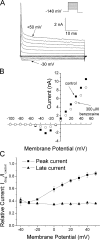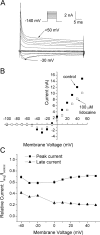Block of inactivation-deficient Na+ channels by local anesthetics in stably transfected mammalian cells: evidence for drug binding along the activation pathway
- PMID: 15545401
- PMCID: PMC2234030
- DOI: 10.1085/jgp.200409128
Block of inactivation-deficient Na+ channels by local anesthetics in stably transfected mammalian cells: evidence for drug binding along the activation pathway
Abstract
According to the classic modulated receptor hypothesis, local anesthetics (LAs) such as benzocaine and lidocaine bind preferentially to fast-inactivated Na(+) channels with higher affinities. However, an alternative view suggests that activation of Na(+) channels plays a crucial role in promoting high-affinity LA binding and that fast inactivation per se is not a prerequisite for LA preferential binding. We investigated the role of activation in LA action in inactivation-deficient rat muscle Na(+) channels (rNav1.4-L435W/L437C/A438W) expressed in stably transfected Hek293 cells. The 50% inhibitory concentrations (IC(50)) for the open-channel block at +30 mV by lidocaine and benzocaine were 20.9 +/- 3.3 microM (n = 5) and 81.7 +/- 10.6 microM (n = 5), respectively; both were comparable to inactivated-channel affinities. In comparison, IC(50) values for resting-channel block at -140 mV were >12-fold higher than those for open-channel block. With 300 microM benzocaine, rapid time-dependent block (tau approximately 0.8 ms) of inactivation-deficient Na(+) currents occurred at +30 mV, but such a rapid time-dependent block was not evident at -30 mV. The peak current at -30 mV, however, was reduced more severely than that at +30 mV. This phenomenon suggested that the LA block of intermediate closed states took place notably when channel activation was slow. Such closed-channel block also readily accounted for the LA-induced hyperpolarizing shift in the conventional steady-state inactivation measurement. Our data together illustrate that the Na(+) channel activation pathway, including most, if not all, transient intermediate closed states and the final open state, promotes high-affinity LA binding.
Figures









Similar articles
-
State-dependent block of wild-type and inactivation-deficient Na+ channels by flecainide.J Gen Physiol. 2003 Sep;122(3):365-74. doi: 10.1085/jgp.200308857. Epub 2003 Aug 11. J Gen Physiol. 2003. PMID: 12913091 Free PMC article.
-
Lysine point mutations in Na+ channel D4-S6 reduce inactivated channel block by local anesthetics.Mol Pharmacol. 1998 Oct;54(4):733-9. Mol Pharmacol. 1998. PMID: 9765517
-
Isoform-specific lidocaine block of sodium channels explained by differences in gating.Biophys J. 2000 Jan;78(1):200-10. doi: 10.1016/S0006-3495(00)76585-4. Biophys J. 2000. PMID: 10620286 Free PMC article.
-
Molecular mechanisms of local anesthesia: a review.Anesthesiology. 1990 Apr;72(4):711-34. doi: 10.1097/00000542-199004000-00022. Anesthesiology. 1990. PMID: 2157353 Review.
-
Interactions of local anesthetics with voltage-gated Na+ channels.J Membr Biol. 2004 Sep 1;201(1):1-8. doi: 10.1007/s00232-004-0702-y. J Membr Biol. 2004. PMID: 15635807 Review.
Cited by
-
A sodium channel mutant removes fast inactivation with the inactivation particle bound.J Gen Physiol. 2025 Jan 6;157(1):e202413667. doi: 10.1085/jgp.202413667. Epub 2024 Nov 27. J Gen Physiol. 2025. PMID: 39601860 Free PMC article.
-
Sodium Channels and Local Anesthetics-Old Friends With New Perspectives.Front Pharmacol. 2022 Mar 28;13:837088. doi: 10.3389/fphar.2022.837088. eCollection 2022. Front Pharmacol. 2022. PMID: 35418860 Free PMC article. Review.
-
Block of human cardiac sodium channels by lacosamide: evidence for slow drug binding along the activation pathway.Mol Pharmacol. 2014 May;85(5):692-702. doi: 10.1124/mol.113.091173. Epub 2014 Feb 21. Mol Pharmacol. 2014. PMID: 24563546 Free PMC article.
-
Molecular mechanisms of pyrethroid insecticide neurotoxicity: recent advances.Arch Toxicol. 2012 Feb;86(2):165-81. doi: 10.1007/s00204-011-0726-x. Epub 2011 Jun 28. Arch Toxicol. 2012. PMID: 21710279 Free PMC article. Review.
-
Bupivacaine blocks N-type inactivating Kv channels in the open state: no allosteric effect on inactivation kinetics.Biophys J. 2008 Dec;95(11):5138-52. doi: 10.1529/biophysj.108.130518. Epub 2008 Sep 12. Biophys J. 2008. PMID: 18790854 Free PMC article.
References
-
- Aldrich, R.W., D.P. Corey, and C.F. Stevens. 1983. A reinterpretation of mammalian sodium channel gating based on single channel recording. Nature. 306:436–441. - PubMed
-
- An, R.H., R. Bangalore, S.Z. Rosero, and R.S. Kass. 1996. Lidocaine block of LQT-3 mutant human Na+ channels. Circ. Res. 79:103–108. - PubMed
Publication types
MeSH terms
Substances
Grants and funding
LinkOut - more resources
Full Text Sources

